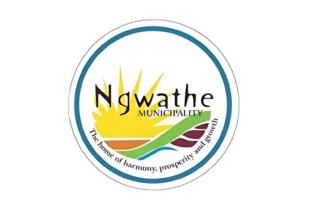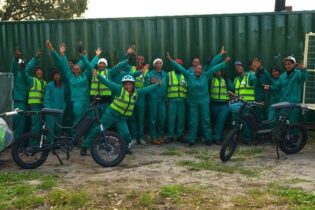Picture: The internal courtyard showing mosaicwork on concrete
The City of Cape Town Human Settlement contact office in Manenberg has recently been awarded a four-star Green Star SA rating – the first fully constructed local municipal building in South Africa to achieve such a rating. The building, designed by Ashley Hemraj with Goodhope Construction as the main contractor, is situated on Landsdowne Road in Manenberg and is used by the local community as a space to make enquiries regarding the housing database, paying their municipal accounts, traffic fines, etc. It was completed in April 2012, with the Green Star rating granted in early August. When embarking on the project, Hemraj had no guidelines regarding what was required in order to obtain a Green Star rating for a municipal building and had to use information available from other sources. However, the final results are a demonstration of Cape Town’s local municipality’s commitment to sustainable development and its green goals. The local community were involved in the mosaic work throughout the building. Members of the community worked with a lead artist to produce the images, while the hanging artwork adorning the public hall space was sourced from a local artist. From a construction point of view, local workers were employed to construct some of the walls using sandbags. “We trained them on site in the sandbag technology, which involved filling, laying and then plastering the bags as well as the assembly of the ‘Eco Beams’,” explains Hemraj.He adds:“Using the local community has resulted in 20% of the labour on site being local when normally it is less than 10%.”The choices of materials were critical on this project, understanding the materials embodied energy in its creation as well as its relation to the site. Many different materials were used in the construction of the building. Along with the aforementioned sandbag construction, FSC timber, reused steel and clay face bricks were used, the latter chosen for its ecological efficient properties. “We selected the Corobrik De Hoop Satin brick, which is made nearby at the De Hoop factory – an advantage when aiming for a Green Star rating.”Hemraj says that it’s important that public buildings stand out from the surrounding buildings and become landmarks, beacons within the communities.Buildings should have a civic presence to them, a stature that speaks of the community and reflects their past, present and individuality. In this case, the red brick offeredidentifies the municipal building in an aesthetically pleasing and contemporary way, and doessoin an environmental responsibly way.
“We are hoping that further buildings in the civic precinct will now follow suit with locally sourced materials. Flooring in the building sees a variety of finishes, including eco-friendly carpets, polished concrete and wood.” From a sustainable perspective, minimising the water footprint was the number one priority in the building, especially considering the future water scarcity in South Africa. Water collected on the roof is used to flush toilets, while elsewhere freshwater is used only for drinking, the rest is treated and reused,e.g.– the garden is irrigated with a drip irrigation system using recycled water from theon-site black-water treatment system. Further sustainable initiatives see solar panels supplying 30 to 40% of energy consumed by the building, while the amount of concrete used in the construction was reduced (and where it was used, fly ash was introduced to reduce the CO2 count). “A four-star Green Star building breaks even on cost/investment, with significant long-term benefits,” explainsHemraj. “We predict that we are saving an estimated R44 000 to R48 000 per year in electricity at the City of Cape Town Housing contact office. That means that at today’s electricity costs we will have a payback for the renewable energy component in just four to five years. In addition to the solar power, a wind turbine supplements electricity on cloudy or rainy days. The electricity is stored in batteries and can run the building for an estimated three days.







